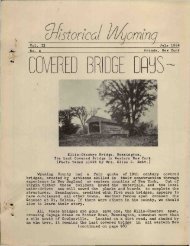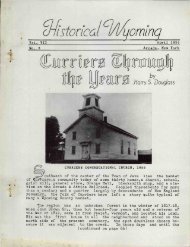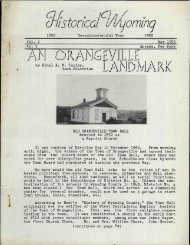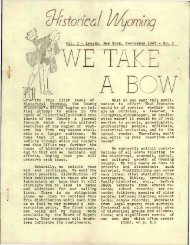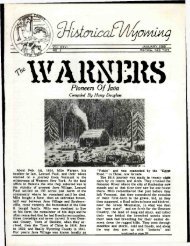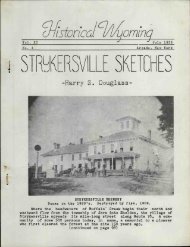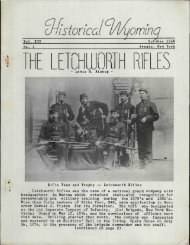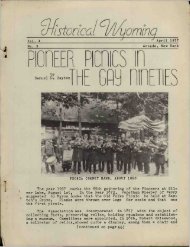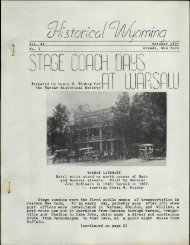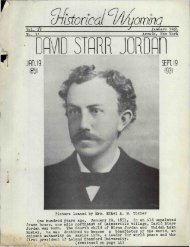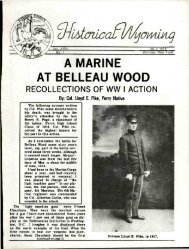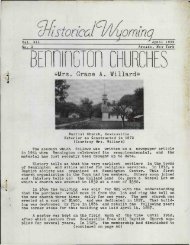By C. Kihm Richardson Walking from Strykersville ... - Fulton History
By C. Kihm Richardson Walking from Strykersville ... - Fulton History
By C. Kihm Richardson Walking from Strykersville ... - Fulton History
You also want an ePaper? Increase the reach of your titles
YUMPU automatically turns print PDFs into web optimized ePapers that Google loves.
APRIL 1978<br />
Memories of Java and <strong>Strykersville</strong> (continued)<br />
communication a system of four telephones is reported<br />
to have connected <strong>Strykersville</strong>, Java, Wales<br />
Center and Portageville in 1894.<br />
If a farmer back around 1890 had boys or girls<br />
of working age it was considered a big help. Of<br />
course they had to be fed, but they did not spend<br />
as much time as now going to school or watching<br />
television and were considered an asset. Shortly<br />
after my grandmother was widowed with three<br />
boys old enough to work and had been moved back<br />
to <strong>Strykersville</strong>, some man stopped and asked her<br />
to marry him. She told him to get out and threatened<br />
to throw boiling water on him if he bothered<br />
her anymore. As I remember hearing this, he<br />
didn't even get off his wagon to make this proposal,<br />
but the boiling water incident suggests that he must<br />
have been off the wagon.<br />
Because my mother's father died when she was<br />
only seven years old, life may have not been much<br />
easier than for her mother, but I think she did get<br />
more education and worked for someone when she<br />
was sixteen to learn tailoring. At seventeen, she<br />
did housework in <strong>Strykersville</strong> and later in East<br />
Aurora. My father, Charles Gilbert <strong>Richardson</strong><br />
got to go away to the equivalent of high school in<br />
the winter. Some of the time it was at Perry where<br />
he could stay with an aunt. He never said much<br />
about the school part but he had to go with his girl<br />
cousin or cousins to dancing class. I can't believe<br />
it was the dancing that he compained about, just<br />
who he had to take because he later loved to dance,<br />
driving quite some distances around the area.<br />
MY FATHER'S FAMILY<br />
When I worked on the history of Java for the<br />
Bicentennial, I copied <strong>from</strong> the histories of several<br />
families and did some interviewing on others but<br />
did not put in about the <strong>Richardson</strong> who came to<br />
Java, <strong>Strykersville</strong> area around 1820. This was<br />
partly because I didn't want it to sound too personal<br />
and partly because I didn't know very much about<br />
them. Charles <strong>Richardson</strong> apparently articled land<br />
where Leonard Holmes now lives and built the front<br />
part of that house.<br />
From what I read in Beers and old deeds he<br />
also had his hand in other businesses such as the<br />
grist mill at Java Village. As happened so much in<br />
those times, his wife died young and he returned<br />
two more times to New England to remarry. From<br />
what Leonard Holmes' father told him, there was<br />
evidence in the front center part of the house that<br />
there had been three fireplaces downstairs and<br />
two upstairs. This was probably the only means of<br />
heating the house at that time. At the southeast<br />
corner was a wing for processing milk, later<br />
moved out back for storage. He must have articled<br />
land running on north up into <strong>Strykersville</strong> in the<br />
town of Sheldon as he donated land for the Baptist<br />
Church, and as he sold off lots along the road, he<br />
retained a strip of land so that he could walk to<br />
PAGE 3<br />
church on his own land. Sounds as though he were<br />
a little something or other but that is what the<br />
old deeds say.<br />
His oldest son, Charles H. <strong>Richardson</strong>, was born<br />
in 1823 (supposedly in that house). He apparently<br />
was in business around Java Village. Either he<br />
and/or his father had land other than the homestead<br />
because some of his children were born in other<br />
towns in the area.v He had married Mary Balcom<br />
in 1845. They had 13 children born between 1846<br />
and 1868. When his father died in 1867, he took<br />
over the homestead farm. Since he had this large<br />
family, I would assume that at that time, the large<br />
addition was made at the rear but it could have been<br />
earlier because his father liked to have meetings<br />
of religious and political groups. In any case, when<br />
the house was remodeled, probably around 1860<br />
or 1870, apparently fireplaces were not the up-todate<br />
thing to have, and all five were torn out and<br />
also the chimneys so that the front area could be<br />
used for a hall and a stairway to the second floor.<br />
Leonard related that when he was doing some<br />
remodeling, he found a letter in a partition written<br />
in 1826. Someone was dunning my great-great<br />
grandfather for money overdue on a mortgage or<br />
note.<br />
My grandfather, Fayette <strong>Richardson</strong>, also ran<br />
the farm for a time before it was sold to Ernest<br />
Holmes, but most of his life he had run a cheesebox<br />
and barrel factory at Java Village in partnership<br />
with his father and/or his brother. My father<br />
operated the mill for the last several years before<br />
it was abandoned. The last year that it amounted to<br />
much was 1914. There were two or three reasons<br />
that it was no longer practical to operate. It was<br />
an old mill and was equipped to do the special<br />
operations to make parts for cheeseboxes and<br />
barrels. To just saw lumber wasn't economical.<br />
A second reason which has always been a drawback<br />
for the area was that although there was<br />
still a market for cheeseboxes not being on a<br />
railroad was a disadvantage and it wasn't possible<br />
to compete with mills better located. Third, the<br />
barrel business had all but disappeared for the<br />
apple buyer wanted apples packed in baskets, not<br />
barrels.<br />
DOCTORING IN THE EARLY DAYS<br />
At one time when he was young, my father had a<br />
job driving for Dr. Fromholtzer in <strong>Strykersville</strong>.<br />
As I remember, the doctor had two teams so that<br />
with bad roads and a lot of territory to cover, they<br />
could spell the horses. The doctor had a driver so<br />
that he could get some rest between calls. What a<br />
doctor could do to help people then seems small because<br />
they had practically none of the many drugs<br />
now available. As late as 1931, I remember a second<br />
cousin died in his home of a certain type of influenza<br />
for which the doctor had no type of treatment.<br />
It was the later 30's when the drugs that really<br />
gave the doctors some weapons came into use.<br />
(continued on page 88)



